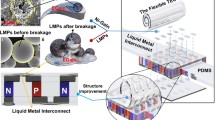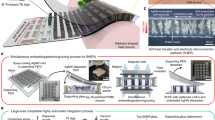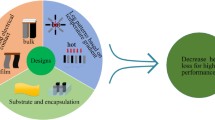Abstract
The market of Peltier devices has been growing in the healthcare, automotive, and sensor industries, yet the cooling performance has been constrained because of their rigidity, small area size, and low cooling capacity. Physically speaking, thinner Peltier sheets could solve these long-known issues because of sheet’s enhanced flexibility enabling to attach on various surfaces, larger cooling area for the same amount of thermoelectric (TE) materials used, and better device cooling capacity. To build the thinner Peltier sheet, we enclosed the deformable hierarchically designed sticky TE materials within the punched holes of 0.5-mm thickness middle layer using the upper and bottom electrode layers. We obtained the flexibility as bending φ 20 mm, 5-times less weight per area, and Peltier effect as the temperature differences over 4 °C between the upper and bottom. This paper suggests the hierarchically designed sticky TE materials pave a way to develop and mass-produce thinner Peltier sheets.
Graphical abstract




Similar content being viewed by others
Data availability
The data generated during the current study are available from the corresponding author on reasonable request.
References
https://www.transparencymarketresearch.com/thermoelectric-modules-market.html. Accessed 28 February 2023
H.J. Goldsmid, CRC handbook of thermoelectrics (CRC Press, 1995), pp.19–26
I. Chowdhury, R. Prasher, K. Lofgreen, G. Chrysler, S. Narasimhan, R. Mahajan, D. Koester, R. Alley, R. Venkatasubramanian, On-chip cooling by superlattice-based thin-film thermoelectrics. Nat. Nanotechnol. 4, 235–238 (2009)
Y. Yu, W. Zhu, X. Kong, Y. Wang, P. Zhu, Y. Deng, Recent development and application of thin-film thermoelectric cooler. Front. Chem. Sci. Eng. 14, 492–503 (2020)
L.M. Goncalves, J.G. Rocha, C. Couto, P. Alpuim, G. Min, D.M. Rowe, J.H. Correia, Fabrication of flexible thermoelectric microcoolers using planar thin-film technologies. J. Micromech. Microeng. 17, S168 (2007)
N. Satoh, M. Otsuka, J. Kawakita, T. Mori, A hierarchical design for thermoelectric hybrid materials: Bi2Te3 particles covered by partial Au skins enhance thermoelectric performance in sticky thermoelectric materials. Soft Sci. 2, 15 (2022)
N. Satoh, M. Otsuka, T. Ohki, A. Ohi, Y. Sakurai, Y. Yamashita, T. Mori, Organic π-type thermoelectric module supported by photolithographic mold: a working hypothesis of sticky thermoelectric materials. Sci. Technol. Adv. Mater. 19, 517–525 (2018)
N. Satoh, M. Otsuka, Y. Sakurai, T. Asami, Y. Goto, T. Kawamori, T. Masaki, G. Yatabe, J. Kawakita, T. Mori, Sticky thermoelectric materials for flexible thermoelectric modules to capture low–temperature waste heat. MRS Adv. 5, 481–487 (2020)
N. Satoh, J.-S. Cho, M. Higuchi, K. Yamamoto, Novel triarylamine dendrimers as a hole-transport material with a controlled metal-assembling function. J. Am. Chem. Soc. 125, 8104–8105 (2003)
N. Satoh, T. Nakashima, K. Yamamoto, Metal-assembling dendrimers with a triarylamine core and their application to a dye-sensitized solar cell. J. Am. Chem. Soc. 127, 13030–13038 (2005)
N. Satoh, L. Han, Chemical input and I–V output: stepwise chemical information processing in dye-sensitized solar cells. Phys. Chem. Chem. Phys. 14, 16014–16022 (2012)
https://espressomilkcooler.com/wp-content/uploads/2015/03/TEC1-12706-site-ready.pdf. Accessed 28 February 2023
F.D. Rosi, B. Abeles, R.V. Jensen, Materials for thermoelectric refrigeration. J. Phys. Chem. Solids 10, 191–200 (1959)
Funding
This study was funded by New Energy and Industrial Technology Development Organization (NEDO), JPNP20004, Norifusa SATOH, and Council for Science, Technology and Innovation (CSTI), Public/Private R&D Investment Strategic Expansion PrograM (PRISM), Jin Kawakita.
Author information
Authors and Affiliations
Corresponding author
Ethics declarations
Conflict of interest
On behalf of all authors, the corresponding author states that there is no conflict of interest.
Additional information
Publisher's Note
Springer Nature remains neutral with regard to jurisdictional claims in published maps and institutional affiliations.
Rights and permissions
Springer Nature or its licensor (e.g. a society or other partner) holds exclusive rights to this article under a publishing agreement with the author(s) or other rightsholder(s); author self-archiving of the accepted manuscript version of this article is solely governed by the terms of such publishing agreement and applicable law.
About this article
Cite this article
Satoh, N., Otsuka, M. & Kawakita, J. Hierarchically designed sticky thermoelectric materials to fabricate thinner Peltier sheets and device architectures. MRS Advances 8, 446–450 (2023). https://doi.org/10.1557/s43580-023-00541-1
Received:
Accepted:
Published:
Issue Date:
DOI: https://doi.org/10.1557/s43580-023-00541-1




